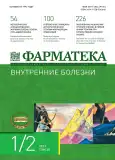Another cause of acute otitis media in adults
- Authors: Angotoeva I.B.1, Kosykov S.Y.1
-
Affiliations:
- Russian Medical Academy of Continuous Professional Education
- Issue: Vol 30, No 1/2 (2023)
- Pages: 177-181
- Section: Pulmonology/ENT/ARVI
- Published: 15.06.2023
- URL: https://journals.eco-vector.com/2073-4034/article/view/462776
- DOI: https://doi.org/10.18565/pharmateca.2023.1-2.177-181
- ID: 462776
Cite item
Abstract
Background. Acute otitis media (AOM) is much more common in children than in adults. Predisposing factors for the development of AOM are dysfunction of the auditory tube, formations that cause compression of the Eustachian tube or obstruction of its ostium; abnormal immune response. It was also revealed that laryngopharyngeal reflux (LPR) causes a violation of mucociliary transport.
Description of the clinical case. Patient S., 32 years old. She went to the clinic with complaints of pain in the right ear, congestion of the right ear for 1 week, fever up to 37ºС, without a runny nose, but the patient was worried about dripping down the back of the pharynx and sore throat. When searching for the causes of recurrence of AOM in an adult woman, taking into account the results of an objective examination of the ENT organs, there was a suspicion that she had LPR, which was confirmed by the results of the tests. Local treatment with the use of ear drops with lidocaine and phenazone, which stopped otalgia and inflammation due to the analgesic component and anti-inflammatory action, made it possible to avoid the appointment of systemic antibiotic therapy. Antireflux therapy and the elimination of the consequences of nonspecific inflammation of the nasopharyngeal mucosa around the tubal fold made it possible to avoid the recurrence of AOM in a patient suffering from LPR.
Conclusion. Although the exact causal relationship between LPR and AOM is still unclear and new clinical and experimental studies are needed to study it in both children and adults taking into account acid, weak acid and alkaline refluxes, this cause of eustachian tube dysfunction must be taken into account in adult patients.
Full Text
About the authors
Irina B. Angotoeva
Russian Medical Academy of Continuous Professional Education
Author for correspondence.
Email: angotoeva@mail.ru
ORCID iD: 0000-0002-6247-619X
Cand. Sci. (Med.), Associate Professor, Department of Otorhinolaryngology
Russian Federation, MoscowS. Y. Kosykov
Russian Medical Academy of Continuous Professional Education
Email: angotoeva@mail.ru
ORCID iD: 0000-0001-7242-2593
Russian Federation, Moscow
References
- Limb C.J., Lustig L.R., Durang M.L. Acute otitis media in adults. In: UpToDate. Available at: https://www.uptodate.com/contents/acute-otitis-media-in-adults. Accessed January 16, 2023.
- Monasta L., Ronfani L., Marchetti F., et al. Burden of disease caused by otitis media: systematic review and global estimates. PLoS One. 2012;7:e36226. doi: 10.1371/journal.pone.0036226.
- Rijk M.H., Hullegie S., Schilder A.G.M., et al. Incidence and management of acute otitis media in adults: a primary care-based cohort study. Fam Pract. 2021;38:448. doi: 10.1093/fampra/cmaa150.
- Ngo C.C., Massa H.M., Thornton R.B., Cripps A.W. Predominant Bacteria Detected from the Middle Ear Fluid of Children Experiencing Otitis Media: A Systematic Review. PLoS One. 2016;11:e0150949. doi: 10.1371/journal.pone.0150949.
- Pettigrew M.M., Gent J.F., Pyles R.B., et al. Viral-bacterial interactions and risk of acute otitis media complicating upper respiratory tract infection. J Clin Microbiol. 2011;49:3750. doi: 10.1128/JCM.01186-11.
- Vasu P.K., Gopalankutty N.V., Somayaji. G. Does laryngopharyngeal reflux disease impair nasal mucociliary transport? A case control prospective study. Int. J. Otorhinolaryngol. Head Neck Surg. 2020;6(4):1–5. doi: 10.18203/issn.2454-5929.ijohns20201022.
- Belafsky P.C., Postma G.N., Koufman J.A. Validity and reliability of the reflux symptom index (RSI). J Voice. 2002;16(2):274–77.
- Belafsky P.C., Postma G.N., Koufman J.A. The validity and reliability of the reflux finding score (RFS). Laryngoscope. 2001;111(8):1313–17. doi: 10.1097/00005537-200108000-00001.
- Анготоева И.Б., Набиева Э.Р. Результаты эндоскопического осмотра изменений слизистой оболочки носа и носоглотки у пациентов с назофаригеальным рефлюксом. Журнал оториноларингологии и респираторной патологии. 2021;4:62–70. [Angotoeva I.B., Nabieva E.R. Results of endoscopic examination of changes in the nasal mucosa and nasopharynx in patients with nasopharyngeal reflux. Zhurnal otorinolaringologii i respiratornoĭ patologii. 2021;4:62–70. (In Russ.)].
- Lechien J.R., Hans S., Simon F., et al. Association Between Laryngopharyngeal Reflux and Media Otitis: A Systematic Review. Otol Neurotol. 2021;42(7):e801–14. doi: 10.1097/MAO.0000000000003123.
- Ивашкин В.Т., Маев И.В., Трухманов А.С. и др. Клинические рекомендации Российской гастроэнтерологической ассоциации по диагностике и лечению гастроэзофагеальной рефлюксной болезни. Российский журнал гастроэнтеролологии гепатологии колопроктологии. 2020;30(4):70–97. [Ivashkin V.T., Maev I.V., Trukhmanov A.S. et al. Clinical guidelines of the Russian gastroenterological association for the diagnosis and treatment of gastroesophageal reflux disease. Rossiiskii zhurnal gastroenterolologii gepatologii koloproktologii. 2020;30(4):70–97. (In Russ.)].
- Katz P.O., Dunbar K.B., Schnoll-Sussman F.H., et al. ACG Clinical Guideline for the Diagnosis and Management of Gastroesophageal Reflux Disease. Am J Gastroenterol. 2022;117(1):27–56. doi: 10.14309/ajg.0000000000001538.
- Lechien J.P., Bobin F., Darpi G. et al. Hypopharyngeal-Esophageal Impedance-pH Monitoring Profiles of Laryngopharyngeal Reflax Patients. Laryngoscope. 2021,131:268–76. doi: 10.1002/lary.28736.
Supplementary files











